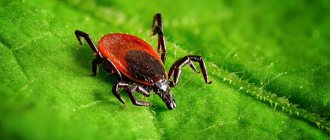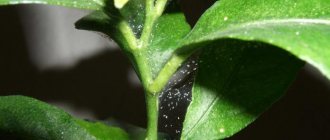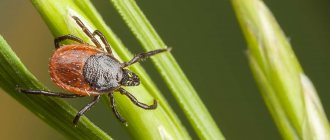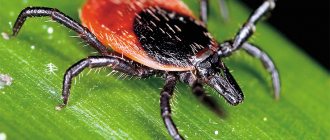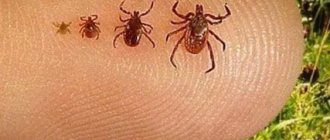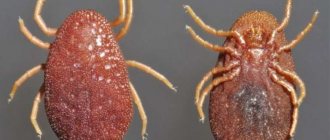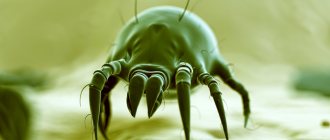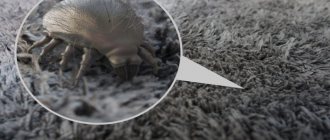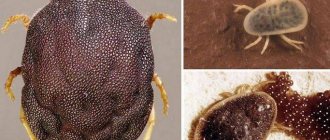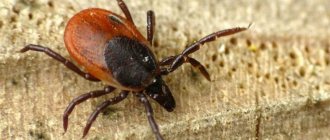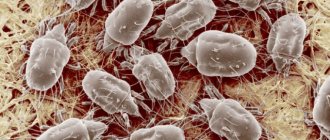Types of tick mouthparts are variations in the structure of ticks' mouthparts, due to the variety of feeding and food acquisition methods.
in house dust mites" title="Types of mite mouthparts - Gnawing mouthparts
house dust mite" />
house dust mite
Gnawing mouthparts
house dust mite
in house dust mites" title="Types of mite mouthparts - Gnawing mouthparts
house dust mite" />
A – structure diagram
B – oral apparatus of a house dust mite
1 – base of gnathosoma, 2 – chelicerae,
3 – cheliceral claws, 4 – palp
The mouthparts of ticks are located at the anterior end of the body, on the gnathosoma, which includes the acron (the anterior segment of the “head”) and two more segments bearing a pair of oral limbs – the chelicerae and the pedipalp (palps). Among mites there are predators, herbivorous mites and parasites, which means that these organisms use different substrates for nutrition. However, despite this fact, ticks, unlike insects, have only two types of mouthparts: gnawing and piercing-sucking. [2]
Gnawing type of tick mouthparts
It is characteristic of mites that are pests of stocks (for example, Flour mite) and many parasitic mites, for example, representatives of families that parasitize the skin of warm-blooded animals and humans (Scabies). The structure of their oral organs is as follows.
The first “inner” pair of oral limbs are called chelicerae; they are usually quite large, claw-shaped, and bifurcate at the end, forming fixed and movable fingers.
The second “outer” pair is called pedipalps (palps, claws), usually has a jointed structure and includes the same segments as a typical leg (coxa, trochanter, thigh, knee, tibia, tarsus).
With the help of cheliceral fingers, food particles are captured and crushed, and the pedipalps hold food near the oral apparatus and/or contribute to better fixation of the tick on the substrate. [3] (photo)
ixodid tick" title="Types of tick mouthparts - Piercing-sucking mouthparts
Piercing-sucking mouthparts
ixodid tick" title="Types of tick mouthparts - Piercing-sucking mouthparts
A - structure diagram
B – mouthparts of the ixodid tick
1 – base of gnathosoma, 2 – hypostome,
3 – palp, 4 – modified chelicerae (proboscis)
homeWelcome to the unofficial website of the staff of the Department of Medical Biology and Genetics of KSMU!
General information about the organization of the educational process at the Department of Medical Biology and Genetics of KSMU
Educational and educational work at the department is carried out in accordance with the following documents:
- State educational standard
- Qualification characteristics of a specialist
- Curriculum for training specialists
- Biology curriculum
- Biology work program
- Study timetable
- Plan of educational and methodological work
The educational process is organized using elements of the following educational systems:
- Information system
, focused on mastering knowledge, skills and abilities in their subject content, in which mastering the content of educational programs is understood as memorizing (memorizing) a certain amount of information, the overall result of the study is considered to be the acquisition of knowledge - “a store of knowledge”, and the main criterion for assessing the activities of the student and teacher is the amount of knowledge acquired by the student;
- operating system
, in which the student develops a clear understanding of what and how to do, and an activity-based approach to acquiring new knowledge is implemented: the student, using visual guidelines, acquires new knowledge and skills in the process of carrying out educational activities;
- person-oriented system
, in which the main emphasis is on cooperation between student and teacher in the educational process, on creating conditions for the self-development of the student’s personality, realizing his creative potential and encouraging him to meaningfully master the basics of his future professional activity.
Training is conducted on the basis of a modular organization
educational process using
a rating system
for assessing students' knowledge.
Main organizational forms
studies at the department are:
- lectures
,
- practical lessons
,
- test papers
,
- independent work.
Throughout the academic year
students of the following faculties study biology:
- therapeutic and prophylactic
- pediatric
- medical and preventive
- dental.
At the end of the first semester, students of these faculties undergo certification
, and at the end of the second semester they take
a test on preparations
of parasitic animals and a final
exam
in biology.
For one semester
students of the following faculties study biology:
- pharmaceutical
- Faculty of Management and Higher Nursing Education (MFSE).
At the end of the semester, students of these faculties take a final exam
in biology.
For most students, traditional group learning is organized; For some students, training can be organized according to an individual plan
studying biology.
Additional organizational forms of training are
- student scientific circle
- biological KEVN
- Olympics.
Much work is being done to develop and use distance learning
.
The site provides didactic material for distance learning.
The active creative participation of students in the development of didactic material and computer programs, the introduction of elements of innovative pedagogical technologies
.
We invite everyone to participate in competitions and olympiads in biology.
Textbooks, methodological recommendations, thematic plans for lectures, practical classes and midterm tests allow each student to have a clear understanding of
- goals and objectives of each stage of training,
- content of education,
- forms and methods of knowledge control.
The organization of the educational process at the department allows each student to actively participate in the educational process, taking into account their goals, requests, interests and intellectual and psycho-physiological characteristics of their personality, ultimately achieving the desired results.
Date of last update 17.09.2010.
Site administrator - Associate Professor V.N. Frosin (tel. 240-41-24)
Piercing-sucking type of tick mouthparts
It is more characteristic of plant pest mites that feed on their sap (for example, the Common Spider Mite), as well as for animal parasites that “prefer” blood as a feeding substrate (for example, the European forest mite), cell contents (if we are talking about about microscopic organisms) and intercellular fluid. [3][1]
This type is distinguished by profound modifications of the oral organs, in comparison with the gnawing apparatus. The movable fingers of the chelicerae are transformed into paired stylets, which pierce the integument of plants or animals, and then, folding into a tube, conduct liquid into the digestive tract. The elongated fixed fingers form a hollow tube - a stylophore, inside of which the stilettos are located. At its base, the stylophore opens into the hypostome groove.
Thus, the stylophore is a protective formation and ensures fixation of the tick on the substrate (microscopic spines and hooks may be located at the edges of its end), and the stylets directly “obtain” food. In some ticks, the chelicerae are transformed into the so-called gnatemal capsule; in others, for example, ixodids, they are modified into the proboscis. [3][2][1] (photo)
The body of relatively large parasitiform mites is weakly divided into a cephalothorax with a proboscis and four limbs and an abdomen. The chitinous cover (exoskeleton) is well developed. The mouthparts are of the piercing-sucking or gnawing type. Some representatives of this order have eyes. Ticks breathe using tracheas and have a circulatory system. The limbs consist of six segments. The stages of tick development are indicated above. Parasitiform ticks include ixodid, argasid and gamasoid ticks.
Classification of ticks
Scientists divide representatives of the Acarina group into 3 independent orders:
- Harvesters are large terrestrial inhabitants of the tropics.
- Acarimorphic mites are the most numerous group, numbering 30 thousand species. Among them there are pests of stocks and pathogens of human diseases. This order includes: barn mite, subcutaneous mite, scabies mite, and feather mite.
- Parasitomorphic mites are an order of arachnids, consisting of 12 thousand species. Among them there are predators, parasites and saprotrophs (destroyers of remains). The group includes the most dangerous pathogens of diseases in humans and animals: ixodid, gamasid, and argasid ticks.
Attention. Parasitomorphic mites have unique adaptive abilities; they have been evolving with their hosts for thousands of years.
Ixodid ticks
Ixodid (ixodid) ticks - carriers of pathogens of piroplasmosis (hemosporidiosis) in domestic animals, belong to the family. Ixodidae Depending on natural and climatic conditions, some ticks live mainly in the forest zone, others in the steppe, others in the foothills, and also in other zones.
Morphology of mites.
Ixodids are relatively large ticks. Their sizes range from 2 mm (hungry) to 20 mm (fed females). The body is not divided into a cephalothorax and abdomen. It is covered on the outside with chitin of unequal thickness. On the dorsal and ventral sides, a thickened layer of chitin forms scutes: dorsal in males and females and ventral only in males. By the size of the dorsal shield it is easy to distinguish males from females: in males it covers the entire upper surface, and in females, as well as in larvae and nymphs, only the anterior part of the body. In the front part of the body are the oral organs, which form the proboscis, consisting of chelicerae (upper jaws), hypostome (lower jaw), a pair of palps (tentacles) and the base of the proboscis. With the help of chelicerae, the tick cuts the animal's skin before sucking blood; the hypostome, armed with teeth directed backwards, is an organ of fixation; The palps serve as an organ of touch. Ticks of different genera may have a long or short proboscis with a quadrangular or hexagonal base. The legs are connected to the tick's body through coxae, which on the anterior pair can be split, weakly split, or unsplit. On the ventral side at the level of the second pair of legs there is a genital opening and behind the fourth pair of limbs there is an anus. In males of most ixodid genera, ventral scutes are located near the anus: adanal - lateral to the anus, accessory - outside the first; some ticks may have subacal scutes located under the adanal scutes. Most mites have an anal groove located behind the anus, while some representatives have an anal groove located in front or absent. On the dorsal side, at the level of the second pair of limbs, some ticks have eyes, and at the back of the body there are depressions called festoons. The spiracles (stigmas) are located on the side of the body, behind the fourth pair of legs and are surrounded by a plate (peritreme) (Fig. 62). In ixodid ticks, the intestines have numerous blind outgrowths that fill with blood during the period of parasitism on animals.
The family Ixodidae includes six genera: Ixodes, Hyalomma, Dermacentor, Haemaphysalis, Rhipicephalus, Boophilus. Over 50 species of ixodids live on the territory of the Soviet Union, most of which are recorded in the southern part of the country.
Biology of ixodid ticks.
Typically, on the body of animals, male ixodids fertilize females, which, after sucking blood, fall off, crawl into shelters and, depending on environmental conditions and the degree of saturation with blood, lay from 4 thousand to 15 thousand eggs in 10-20 days, after which they die. Tick eggs are relatively large (about 0.5 mm in length), oval in shape, yellow-brown in color, covered with a hard shell, and immature. The eggs mature within a few weeks (up to a month or more). Through the resulting crack in the egg shell, a larva about 1 mm long hatches, has three pairs of legs and lacks spiracles, genital opening and peritreme. To transform into the next stage (nymph), the larva must suck blood (more often on small wild animals and birds). The nymph has four pairs of limbs, but lacks a genital opening. After sucking blood (often in wild animals), the nymph detaches from the host and falls to the ground or turns into an imago on the animal’s body. Thus, to fully develop from the egg to the mature stage, ixodid ticks suck blood from several or one animal three times and molt twice. The duration of blood sucking by larvae is on average 3-7 days, by nymphs - 3-10, by adults - 8-10 days. Most ticks overwinter in the external environment at various stages of development. Depending on the type of development and feeding method, ixodids are divided into single-host, two-host and three-host.
Single-host mites
all three active stages of metamorphosis take place in one animal, and only the imago leaves it to lay eggs in the external environment (Boophilus calcaratus, Hyalomma scupense).
Two-host ticks
in the larval and nymph stages they live on one host and in the imaginal stage on another (Rhipicephalus bursa, Hyalomma plumbeum, Hyalomma detritum).
Three-host mites
successively change three hosts, and the transformation of one stage into another always occurs in the external environment. This type of development is typical for most ixodid ticks (Ixodes ricinus, Dermacentor pictus, etc.).
The larvae and nymphs of two-host and three-host ticks prefer to attack mouse-like rodents, birds, and less often reptiles, while adult ticks, as well as the larvae of single-host ticks, attack domestic and large wild animals (roe deer, wild boars, etc.).
Genus Ixodes (trailer).
Representatives of this genus have a long proboscis with a quadrangular base. There are no eyes. Cokes I are not split. Anal groove in front. In males, the entire ventral surface is covered with scutes (Fig. 63). The dorsal shield, limbs and proboscis are dark brown, the cuticle of females is grayish-yellow. Ixodes ricinus and Ixodes persulcatus are widespread on the territory of the USSR. They develop according to the three-host type and are moisture-loving.
Ixodes ricinus is one of the most common ixodid ticks. It is found in greatest quantities in the northwestern and central regions of the USSR, and is almost absent in the steppe and semi-desert zones. During the year, 1 generation develops. Ticks can go hungry for more than two years. Adults attack animals in spring and autumn. It is a carrier of Babesia bovis, Francaiella caucasica and Anaplasma marginale.
Ixodes persulcatus is distributed mainly in the taiga zone of Siberia and the Far East, as well as in the regions of Karelia and the Leningrad region. The adult attacks animals in the spring and summer (no later than July). This tick carries Babesia bovis and Francaiella caucasica.
Genus Hyalomma (glasseye).
Of the ixodids, these ticks are the largest (up to 2.5 cm), have a dark body color, a long proboscis with a quadrangular base and clearly visible eyes. Coxae I are split, the anal groove is posterior and there are three pairs of central scutes in males (Fig. 64). They are warm-dry-loving mites, therefore they are widespread in the steppe, semi-desert and desert zones. The species Hyalomma scupense are classified as single-host ticks, Hyalomma detritum and Hyalomma plumbeum are classified as two-host ticks, and Hyalomma anatolicum and Hyalomma asiaticum are classified as three-host ticks. Some species (Hyalomma scupense, Hyalomma detritum and Hyalomma anatolicum) often live in barnyards. Most ticks attack animals from spring to autumn (maximum in June), with the exception of Hyalomma scupense, which parasitize domestic animals during the cold season (from autumn to spring).
Representatives of this genus are carriers of the pathogens piroplasmosis and nuttalliosis, theileriosis, as well as anaplasmosis in cattle.
Genus Dermacentor (leather cutter).
Ticks of this genus are characterized by a spotted pattern with a silvery tint on the dorsal shield in males and females, so they can be easily distinguished macroscopically from other iscodids. Dermacentor mites have a short proboscis with a quadrangular base, eyes, an anal groove located posterior to the anus, and split coxae I (Fig. 65). They are widespread in different zones of the country, develop according to the three-host type: larvae parasitize mainly on mouse-like rodents, nymphs - on larger wild animals (hedgehogs, hares) and birds, adults - on domestic and some large wild animals (wolves, etc. ).
Mature ticks more often attack animals in spring and autumn. They are capable of fasting for a long time (up to three years). The species Dermacentor marginatus, Dermacentor nuttalli, Dermacentor silvarum, Dermacentor pictus, Dermacentor daghestanicus are of veterinary importance as ectoparasites and carriers of causative agents of piroplasmosis and nuttalliosis in horses, piroplasmosis in dogs, as well as theileriosis and anaplasmosis in sheep.
Genus Haemaphysalis (bloodsucker).
These are relatively small mites that have a short proboscis with a quadrangular base, unsplit coxae I, and an anal groove behind the anus. Ticks of this genus lack eyes and ventral scutes in males. Ticks are found in the steppe and forest-steppe zones, as well as in the foothills. The development of one generation lasts more than a year. The three-host ticks Haemaphysalis otophila and Haemaphysalis puncata are of veterinary importance; they transmit Piroplasma bigeminum, Piroplasma ovis and Theileria annulata.
Genus Rhipicephalus (fanheads)
. Heat-loving, relatively small mites are red-brown in color, they have a short proboscis with a hexagonal base. They have eyes, split coxae I, a groove located behind the anus, and two pairs of central scutes in males (Fig. 66). Ticks are common in the North Caucasus, Transcaucasia, Crimea and Central Asia (in the foothills and steppe regions). Animals are attacked in the spring-summer period of the year. Within a year, the development of one generation of mites ends. The most common species of this genus are the two-host tick Rhipicephalus bursa (the main vector of sheep piroplasmids) and the three-host tick Rhipicephalus turanicus (the vector of NUttallia equi, Anaplasma rossicus, Anaplasma ovis N).
Genus Boophilus (bull lover).
Only one species, Boophilus calcaratus, has been recorded on the territory of the Soviet Union. This is a heat-moisture-loving mite and develops according to the single-host type. It has a short proboscis with a hexagonal base, eyes, weakly split coxae I and two pairs of ventral scutes in males. Females have a light brown cuticle and a tongue-shaped dorsal shield. This tick often attacks cattle, less often horses, and very rarely sheep. It does not parasitize small wild animals. It is often found in Crimea, the Caucasus, and Central Asia. The development of one generation lasts about two months (on an animal 20-24 days and on land 30-45 days). During the warm season of the year, 2-3 generations of ticks develop. The larva is capable of starving for up to seven months (Fig. 67). It is a carrier of the causative agents of piroplasmosis, southern francaiellosis and anaplasmosis in cattle.
Variety of species
Among the most common types:
Ixodidae
Representatives of the order parasitize vertebrates (birds, mammals, reptiles). All of them are large in size - 3-30 mm; when fed with blood, the body increases in size. They live in all climate zones. The body is flat, oval in shape. They can parasitize on one, two or three hosts. In females, larvae and nymphs, the scutellum covers only a small part of the body. The rest of the surface is very elastic. During feeding, it stretches, allowing the size of the idiosome to increase several times. Males are designed differently; the dorsal shield covers the entire body. They cannot feed for 6-10 days like females. Hungry individuals are yellow, brown or black. After feeding they become gray or pinkish.
The ixodid tick parasitizes birds, mammals, and reptiles
Attention. The order includes carriers of the most dangerous diseases: tick-borne encephalitis, tularemia, typhoid, Q fever, Lyme disease.
The duration of the life cycle depends on the seasonality of feeding and reproduction. A fertilized female requires blood to develop her eggs. The laying is done in the forest floor. Autumn larvae overwinter hungry; in favorable conditions they require 1-4 weeks to develop. They feed on rodents. After molting, the larva turns into a nymph. It remains in this state throughout the warm season. In the absence of food, the tick nymph overwinters in this state. Its transformation into an adult is delayed until spring.
Blood-sucking activity occurs with the arrival of heat and humidity. The most dangerous periods for people are considered to be from May to July. Hungry adults and nymphs lie in wait in the grass and bushes. They are able to sense a person several meters away. To attach itself, the tick looks for a place with thin skin. They prefer the armpits, groin, neck, and behind the ear. Thanks to the introduction of an anesthetic substance into the wound, a person does not notice the puncture of the skin. Special protective equipment for walking and the use of acaricidal repellents will help prevent a bite.
Argasid mites
Representatives of this species parasitize poultry and animals. The body of arachnids has a dense leathery covering, their length is 3-30 mm. After saturation, the yellowish-brown color changes to purple. When a person is bitten, a severe allergy to the saliva of the tick occurs. Surprisingly, adults of this species can withstand an eleven-year hunger strike.
Barn mites
This group includes microscopic pests of grain, cereals, plant root systems, and cheese. Arthropods do not exceed 0.5-0.6 mm in size. Females lay eggs in food. After 4 days, hungry larvae emerge from them. After 5 days she turns into a nymph. Pests are resistant to high and low temperatures. They quickly spread with contaminated products. If it enters the respiratory tract, it causes asthmatic symptoms.
Dust mite
Synanthropic organisms live in every human home. A body 0.1-0.3 mm long cannot be seen without special devices. Their full life cycle is 60-70 days. Favorite habitat is bedding, pillows, mattresses. Parasite feces contain enzymes that cause severe allergies.
Oribatids or oribatid mites
Oribatids are the most numerous group of arthropods living in the soil. A characteristic feature of oribatid mites is their slow metabolism. They feed on plants, dead organic matter, mushrooms, and animal corpses. Their length is 0.7-0.9 mm, their habitat is forest litter, upper layers of soil.
Gamasid mites
This group includes 6 thousand species, among them there are parasitic and free-living families. Their representatives have a body size from 0.2 to 5 mm and are yellow or light brown in color. Among the most dangerous types: rat and mouse ticks. They are carriers of diseases. When bitten, it causes tick-borne dermatitis. The chicken parasite harms poultry farming, causing illness and even death of the livestock.
Demodex
A parasitic mite that lives in hair follicles. The length of its body is 0.3-0.4 mm. It feeds skin cells with fat. The body of the parasite is covered with scales, which help it to gain a foothold on the host. Moves along the surface of the skin. Most often affects older people (2/3 of cases).
Scabies itching
An intradermal parasite that causes scabies. The size of a male zudny is 0.23 mm, a female is 0.45 mm. The parasite gnaws holes in the host's skin. In them it reproduces and feeds on blood. Most often it affects the hands, armpits and groin.
Features of methods of combating ixodid ticks
Ixodid ticks can parasitize animals and be found indoors and on pastures. The destruction of ticks in their habitats is the most radical method of a set of anti-pyroplasmidosis measures. Tick control is successful if it is carried out in a planned manner over a wide area in a comprehensive manner - with the simultaneous destruction of ticks on animals and in the external environment (indoors and on pastures). Depending on the season of the year, the species, age and general condition of the animals, on the one hand, the species composition, developmental phases and places of localization of ticks, on the other, different acaricidal agents and methods of their use are recommended.
Nutrition
The diet of arachnids is determined by their lifestyle. Herbivorous families (spider mites, gall mites) suck sap from leaves, stems or roots. This leads to slower growth, drying out and death of the crop. Agricultural pests are controlled using acaricidal drugs. Predators feed on eggs, insect larvae, or representatives of their own order. The Phytoseiidae species is used by gardeners to control phytophagous mites.
Saprophages living in the soil eat rotting plant debris, bacteria, spores, and algae. They contribute to soil recycling and humus formation. Some species of acarimorphic mites feed on food supplies. They settle in warehouses, mills, and barns. They eat flour, cereals, grains, seeds, dried fruits and nuts. Parasites feed on the blood, secretions of the sebaceous glands, hair or skin of the host. According to the method of parasitism, they are divided into two types: subcutaneous and cutaneous.
Attention. Adults can fast for two years without harm.
Destruction of ticks on animals
In the fight against ticks parasitizing animals, mechanical (collecting ticks) and chemical methods (treating animals with dusts, solutions, emulsions, suspensions and aerosols of acaricidal preparations) are used. They are used for the extermination of ticks and for preventive purposes (bites and suction of these parasites and the disease of animals with protozoal and infectious diseases are prevented).
Manual collection of ticks.
Ixodid ticks are collected and destroyed from cows by milkmaids, and from horses by riders and grooms when cleaning the animals. When collecting ticks, you should take into account their favorite locations. For example, Rhipicephalus bursa mites often attach themselves to sheep in the ears, dewlap, groin and under the tail; Boophilus calcaratus - in cattle, mainly on the skin of the udder, scrotum, perineum, groin and dewlap; mites of the genus Dermacentor - in horses in the intermaxillary space and at the base of the mane.
Ticks collected from animals should not be crushed by hand to avoid infection with some dangerous diseases; they are placed in a jar of kerosene. This method has limited use due to its high labor intensity and low labor productivity, as well as its low efficiency (in most cases it is possible to detect and collect only well-fed female ticks).
Destruction of ticks by chemical means
- a widely used method in industrial settings. To combat ticks on the body of animals, a wet method is used (bathing in baths, spraying, wiping), and in the winter season - a dry method (treating the skin with acaricidal dusts). The most effective and widely used in the fight against ixodids is the wet method of anti-tick treatment of livestock.
In the form of solutions, emulsions and suspensions, the following acaricides are prescribed for treating the skin of animals (with an interval of 6-7 days):
1) 1% chlorophos solution - 1-3 liters of solution for each animal;
2) sevin suspension (0.75-1%) - 1-3 liters for each animal;
3) 3% polychlorpinene emulsion (only for young cattle) - 1.5-3 liters of emulsion per animal (rarely used);
4) 2% emulsion of the drug SK-9 (dairy cows and slaughter animals cannot be treated) - up to 3 l (depending on the age and weight of the animal);
5) 1% emulsion of trichlorometaphos-3 (only young cattle can be processed) - 1-2 liters of emulsion for each animal (no later than 60 days before slaughter);
6) sodium arsenite with different concentrations of arsenous anhydride (A2O3) for different types of animals (0.16% for bathing cattle, 0.18% for bathing sheep and 0.24% for wiping horses).
Sometimes, to kill ixodids on animals, a 0.5% solution of chlorophos in a 0.1% solution of caustic alkali is used.
Of the ixodid ticks, representatives of the genus Ixodes are the most resistant to acaricides, while ticks of the genus Boophilus (especially the larvae) show minimal resistance. The remaining ixoids occupy an intermediate position. In ticks of the same genus, males, as well as hungry ticks (at all phases of development), die faster from acaricides.
Bathing animals in baths
characterized by high efficiency. Animals are bathed in the warm season. In veterinary practice, stationary baths (swimming pools) and portable baths (metal, wood and canvas) are used. The most widespread on collective and state farms are stationary bathtubs-pools, located on a flat, dry area, away from roads and buildings. They are trenches with a concrete bottom and walls. Dimensions of a typical cattle bath: bottom length 7 m, waterline length (liquid level in the bath) 14 m, bottom width 0.6 m, waterline width 1 m, depth from bottom to liquid level 1.85 m, the height of the sides above the waterline is 0.5 m. The entrance platform is arranged at an angle of 45° (sliding), and the exit ladder is at an angle of 20° (5 m in length). The length of the entrance corridor is 3-5 m, width 0.8-1 m. Adjacent to the exit side of the bath is a cemented platform through which the liquid flowing from the animals enters the bath. On the side of the bath there is a sump connected to the bath by a pipeline with a valve. In front of the entrance and exit from the bath, there are corrals for livestock. This bath is designed for approximately 20 thousand liters of acaricidal liquid. You can also bathe sheep in it.
The liquid level in the bath is measured with a water meter, and the length and width of the bath with a tape measure. A few days before mass bathing, the quality of emulsions or solutions of acaricides is checked on a small group of low-value animals. Young and weak animals are bathed separately. Animals should be given a drink before bathing. You should not bathe animals in rainy weather or during hot hours of the day.
After bathing 300-600 heads of cattle, an emulsion or solution of an acaricidal drug is added to the bath to the original volume. The acaricidal liquid is replaced and dirt is removed from the bath after bathing 2500-3000 animals. Among domestic animals, sheep are the most convenient to bathe (Fig. 68). Pregnant cows, ewes, sows and young animals under 6 months of age are not bathed, but are carefully sprayed with acaricidal preparations. In order to mechanize the bathing of sheep, farms use a Dokuchaev bathtub with a tilting platform.
Treated animals are placed in ventilated rooms or pens, protected from sunlight and wind. Currently, hand bathing of animals has limited use due to its high labor intensity and low labor productivity.
Spraying and wiping down animals
used in farms with a small number of livestock, in the absence of baths, which often occurs in the central and northern regions of the country, as well as for the destruction of ixodid ticks in pregnant and weak animals and in young animals up to six months of age. For spraying and wiping, veterinarians successfully use solutions, emulsions and suspensions of the above drugs.
It is convenient to decontaminate large animals (cattle, horses, camels) in shower chambers (automatic supply of acaricide). Animals are often sprayed in fenced areas using machines (DUK, LSD-2, VMOC-2, EMSOZH, etc.). During the processing period, animals are fixed in a split or in a pen.
Manual sprayers (hydropolettes of various systems, etc.), as well as manual wiping of animals, have limited use due to their low productivity. After treating the skin with acaricides before milking, the udder of cows (as well as mares) is washed with water. Animals are not put out to pasture until the skin is completely dry.
Aerosols
used in the fight against ixodid ticks and insects on animals, indoors and on pastures. Aerosols are tiny droplets of liquid or small solid particles suspended in a gaseous medium. Aerosols with liquid particles are called mists, and aerosols with solid particles obtained by condensation are called fumes. An example of condensation aerosols is natural fogs. Aerosol particles have different sizes and shapes: in fogs they are spherical, and in smoke they have a regular crystalline shape. Aerosol particle size, i.e. the degree of its dispersion varies widely. A number of physicochemical properties of aerosols (evaporation, diffusion, sedimentation, etc.) depend on the size of the particles and their shape. In the fight against harmful arthropods, aerosols with a particle size of 0.1-1000 u are used in the form of oil mists (aerosol cans) and fumes (acaricidal bombs). Aerosols of acaricides and insecticides are more often used to kill parasitic arthropods indoors and on pastures and much less often on animals.
Treatment of animals with acaricide dusts
- a dry method of combating parasitic mites and insects, carried out mainly in the winter season. Dusts are a powdered form of insectoacaricides, in which the active substance is mixed in certain proportions with a neutral filler (talc, kaolin, ash, chalk).
Neutral, or indifferent, substances reduce the humidity of the air under the fur and absorb lymph on the surface of the skin, creating unfavorable conditions on the skin of animals for parasitic arthropods. Currently, dusts of sevin (7.5%), chlorophos (5-10%) and other acaricides are used. Decontamination of animals with dusts is carried out in walking areas or in rooms with good ventilation, in which there is no fodder. To apply dusts to the skin of animals, you can use special pollinators (OZHU-5) (this treatment is often carried out manually).
People working with dusts must wear rubber or canvas gloves, safety glasses and gauze bandages over their nose and mouth. After the end of dusting, the animals are carefully removed from the ground or floor, and the udders of dairy cows are washed with soap.
Ticks of the family ixodidae (Murrey, 1877)
Morphology of ixodid ticks. More than 49 species of ixodid ticks have been registered in the CIS. All of them are temporary ectoparasites of vertebrate animals and carriers of pathogens of many diseases of mammals and birds: arboviruses, bacteria, blood parasites, rickettsia, etc.
Ixodid ticks are the largest; the size of females that have drunk the blood of animals can reach 20-30 mm. Segmentation of the body is not pronounced; the head, thorax and abdomen are fused into a continuous, undivided body, resembling a flattened sac, narrowed anteriorly. In the front part of the body there is a proboscis - the gnathosoma, followed by the idiosoma (the body itself). The proboscis, an organ of fixation, consists of a base, or collar, a dense chitinous plate of three-, four-, five- or hexagonal shape; pairs of upper jaws (chelicerae), which serve to cut the skin of the animal; hypostome (fused lower jaws), shaped like a harpoon, covered with teeth directed backwards for strong attachment to the host’s body; two four-segmented palps (palps), acting as organs of touch. At the base of the proboscis, females have a special sensitive organ - pore fields.
Adult ixodid ticks exhibit pronounced sexual dimorphism. On the dorsal side of the tick idiosome there is a scutum (scutum) - a thick, shiny chitinous formation. In males, the scutellum covers the entire dorsal side, while in females it covers only 1/3 of the idiosome behind the proboscis. This feature is the main difference between females and males. The color of the shield is often dark brown or gray. There are grooves on the scutum, the color, shape and number of which have diagnostic significance. The body color of drunken females varies greatly from steel-blue to light gray with a brownish or pinkish tint. The color of ticks that sucked lymph is always lighter than those that fed on blood.
In ticks of the genera Boophilus, Dermacentor, Rhipicephalus, Hyalomma, eyes are located on the sides of the shield, approximately at the level of the second pair of legs.
On the ventral side of the idiosome, the mite has a genital opening (at the level of the first–second coxa) and an anus (far behind the fourth pair of legs). In all genera (with the exception of Boophilus), an anal groove runs near the anus, going around it in front (only in Ixodes) or behind (in all other genera). Four pairs of jointed legs are attached to the idiosoma on the ventral side. Adults and nymphs have four, and larvae have three pairs of legs, consisting of five segments: a coxa (coxa), fixedly attached to the body, a trochanter, a thigh, a tibia, and a tarsus, which has a sucker at the end and two claws. The body (together with the scutum) and limbs are covered with a varying number of bristles, which, together with suction cups and claws, serve the mites for crawling and attaching to the animal’s cover and human clothing; The bristles serve as organs of touch. On the paws of 1 pair of legs there is an organ of smell - Haller.
The internal structure of ticks includes the digestive, respiratory, excretory, reproductive and nervous systems.
The digestive apparatus begins at the base of the hypostome with the oral opening, followed by the pharynx, which gradually passes into the esophagus, which flows into the central intestinal canal with long convoluted blind branches extending from it. The small intestine extends from the midgut, connecting, like the hind intestine, to the rectal bladder, where excretory products accumulate. The rectum opens with the anus, closed by a special valve. One female can suck 2-3 ml and stock up on a large amount of blood necessary for the formation of eggs. On the sides in the front of the body there are paired cluster-shaped salivary glands; The saliva produced during feeding is excreted through the salivary ducts through the mouth into the host's wound. Saliva has lysing properties, prevents the clotting of blood entering the intestines, and anesthetizes the bite.
The excretory apparatus consists of one pair of long, thin tubes (Malpighian vessels) winding throughout the body cavity. One end of them is blind, lies freely in the body cavity, the other flows into the rectal bladder.
The respiratory apparatus consists of a dense network of respiratory tubes - tracheas, extending from the common and cephalic trunks. A dense network of branched tracheas covers all parts of the body and opens outward along the edges of the body behind the fourth pair of legs with two spiracles (stigmas) located on special plates - peritremes (their shape is taken into account when identifying ticks).
The circulatory system is not closed. The blood of ticks (hemolymph) is colorless, washes all the organs of the body and enters the heart, which has the shape of a thickened sac. The aorta and trunks extend from the heart, supplying blood to the legs, proboscis and brain.
The nervous system is a single solid mass located in the front of the body on the ventral side. Many nerves extend from the brain to the limbs, eyes, mouth and internal organs.
The sense organs include the eyes (with the exception of the genus Ixodes and Haemaphysalis), a special organ of smell - Haller's organ, located on the paws of the first pair of limbs, as well as tactile bristles covering the body, proboscis, and limbs.
The female reproductive organs consist of the ovary, oviducts, uterus, spermatic receptacle, vagina, and a pair of accessory glands. In addition, there is a Zhene organ that produces a secretion that lubricates the eggs during laying. In males, the genital organs are represented by the testes, vas deferens and accessory glands.
The development cycle of ticks goes through transformations (metamorphoses): egg, larva, nymph and adult – sexually mature females and males. The female lays from 3-4 to 10 or more thousand eggs and dies (one gonotrophic cycle). After a certain period of time (1-2 weeks), depending on temperature and air humidity, the eggs hatch into six-legged larvae measuring 1.0 × 0.5 mm. Some time after the larvae emerge from the eggs, they become ready to attack animals and suck blood. The drunken larva increases in size and after 5-10 days molts into a nymph with four pairs of legs. The size of a hungry nymph is 2-3 mm. For subsequent development, the nymph must also drink blood, and then it turns into the adult phase - male or female. Ixodid ticks feed on the host's body a certain number of times over several days in each active phase. Depending on the type of food, one-, two- and three-host species are distinguished.
In single-host ticks (Boophilus calcaratus, Hyalomma scupense), the larva, nymph and mature individuals feed on the same animal on which they molt. Fertilization of females by males occurs in animals during the sucking period. Only well-fed, sexually mature ticks leave their host. The fallen females look for suitable places in crevices, under stones, under dead parts and roots of plants, under dry manure, etc., lay eggs and die.
In two-host ticks (some species of the genera Rhipicephalus, Hyalomma), development occurs on two hosts. Larvae and nymphs feed on the former. Here the larvae, without detaching, turn into nymphs on the spot, which, after feeding, fall off the host to the ground and turn into mature ticks. The latter attack the animal - the second owner, having fed, leave it to lay eggs on the ground.
In three-host ticks (genus Ixodes, Haemophysalis, Dermacentor, some species of the genera Hyalomma and Rhipicephalus), all three phases - larva, nymph and mature individuals - feed on three different animals, i.e., each phase leaves the host’s body after the end of blood-sucking. Larvae and nymphs feed on the blood of small mammals.
The lifespan of ticks varies. Larvae are capable of fasting from several months to a year, sexually mature individuals of some species - for several years. Hungry adults, drunken nymphs, and tick eggs overwinter in nature.
METHODS FOR COLLECTION AND STUDY OF IXODID TICKS
Methods for collecting ticks are divided into epizootic and regular, universal and selective, complete and partial. Epizootic collections are usually used to determine the degree of well-being of an area (farm) in relation to ticks; they are carried out both in natural and guest biotopes. Regular census collections and observations are carried out either continuously for a certain period of time, or at intervals of several minutes and hours, 5-10 days, and even up to several months. Collections can be general in case of a small number of animals and selective in case of a large number of animals. A harvest is called complete when all visible parasites are caught on animals. During partial collection, only an arbitrary number of parasites are counted and counted on a conventional scale designated: “very many”, “many”, indicating approximately the number for each designation.
The direct collection method involves partial or complete collection of ticks found on animals. When collecting from animals with short and straight hair, use a thin wooden plank (size 15-20 × 5 cm) with pointed long edges. It is carried out against the hair, looking at the skin behind the plate for the presence of ectoparasites.
A survey of the area for the presence of ticks is carried out in order to identify inhabited and uninhabited areas, the boundaries of these areas, species composition, the dynamics of the seasonal number of these arthropods in pastures, etc. (for this purpose, devices are used: a drag net, a flag, a towel, a screen, etc.) . The area can be examined using the method of route epizootic and regular tick counts in open nature, near livestock buildings, runs, watering places and resting places for animals. All received data is plotted in the form of symbols on a schematic map of the farm territory.
The best preservative liquid for ticks is 70% alcohol, 4-5% aqueous solution of formaldehyde. All ticks isolated from each count (from an animal, from pastures, etc.) are placed in a separate container, and the appropriate label is also placed there. During further processing, ticks are divided into genera and species, and then the number is calculated for 10 days or more. For greater clarity, the results obtained are depicted in the form of curves and diagrams.
When collecting ticks, you should reliably protect yourself from attacks by parasites. To protect your hands, you should use mesh handcuffs impregnated with a composition containing phthalate. The sleeves are made from a piece of mesh measuring 35x25 cm, trimming the edges with braid and sewing them in the form of a cylinder with a diameter of 18 cm. The sleeves are tied to the cuff of a tunic, shirt, etc.
DIFFERENTIAL DIAGNOSTICS OF TICKS OF THE FAMILY IXODIDAE
1. GENUS BOOPHILUS , Curtice, 1891. Body length of hungry individuals is 15 mm. The color of the scutellum is from yellow-brown to light brown. The eyes are flat and lateral. The proboscis is short, its base is hexagonal. The palps are short and ribbed. Males have two pairs of scutes on the ventral side of the idiosome. In the CIS it is recorded in the forest-steppe of southern Ukraine, the North Caucasus, Kazakhstan, Central Asia and Transcaucasia. Biotopes include river valleys, damp meadow thickets, and livestock buildings. The feeders are large and small cattle and horses. Active period from spring to December.
Boophilus calcaratus, Birula, 1895 – single-host tick. It is a carrier of Piroplasma bigeminum, P. ovis, Babesia colchica, brucellosis, Q fever.
2. GENUS HYALOMMA , Koch, 1844. Ticks are the largest in the family. IXODIDAE. The proboscis is long, its base is rectangular, the coxae of the first pair of legs are deeply split. Males have 2-4 pairs of scutes on the ventral side. The peritrema is occipital or retrovidous. The legs are powerful and long. Their biotopes are steppe, desert and semi-desert landscapes; some species live in shrubs, open forests, lowland and mountain forests, and in livestock buildings. They are carriers of pathogens of piroplasmosis, possibly tick-borne typhus, hemorrhagic fever, human Q fever, plague, leptospirosis and animal brucellosis. From this genus, farm animals are parasitized by the species H. anatolicum, H. detritum, H. plumbeum, and H. scupense.
H. Anatolicum, Koch, 1844, Found in floodplain meadows, fallow lands, livestock buildings near the nests of synanthropic birds in Central Asia, Kazakhstan, Transcaucasia and the Northern Caucasus. The hosts are cattle, horses, sheep, etc. The tick is a three-host tick. Adults are found on animals in April-May-June; larvae - in July-August, nymphs - in autumn and winter; parasites have one generation per year. The tick is a carrier of Theileria annulata, Th. mutans.
H. Detritum, Schulze, 1919, carrier of Theileria annulata, Th. mutans. The northern border of its range runs through Transcaucasia, Southern Kazakhstan, and throughout Central Asia. The tick has two hosts: larvae and nymphs parasitize one host, and adults parasitize another host. Active in May-September, all agricultural animals can be feeders. One generation develops per year.
H. Plumbeum, Koch, 1844, is found in intermountain valleys, deciduous forests, forb fallows, stacks and haystacks in the south of Ukraine, in Transcaucasia and Central Asia, in the south of Kazakhstan. The hosts are large and small domestic and wild mammals (imago) and brown hare, wild and domestic birds, mouse-like rodents (larva and nymph). The tick has two hosts and feeds on animals from July to October. It is carried by Piroplasma caballi, Nuttallia equi.
H. Scupense, Schulze, 1918, is a single-host tick. The northern border of the range passes in Ukraine, in the Kursk and Saratov regions, the Lower Volga region, and Central Kazakhstan. To the south, ticks are found everywhere in mixed-grass floodplain meadows. They parasitize animals during the cold season (October-May). Vector by Theileria annulata, Nuttallia equi.
3. GENUS DERMACENTOR , Koch, 1844. Characteristic of all species is the presence of silver-white (light enamel) spots on a dark background of the dorsal shield (marble pattern), limbs and proboscis. The proboscis is short, the palps protrude beyond the rectangular base of the proboscis. The eyes are flat and marginal. Males without ventral scutes. All species develop according to the three-host type. Ticks have one generation per year, the imago lives up to two years. They live in forests, steppes, and semi-deserts; in mountainous areas at an altitude of more than 2000 m above sea level they are carriers of pathogens of piroplasmosis, tick-borne encephalitis, tick-borne rickettsiosis, plague and tularemia.
D. marginatus, Sulzer, 1776 – carrier of Piroplasma caballi, Nuttallia equi, A. marginale, A. ovis, Th. recondita. Ticks are found in Ukraine, Moldova, Crimea, Voronezh region, the Middle and Lower Volga region, Kazakhstan, the North Caucasus, the southern part of Western and Eastern Siberia and Central Asia. Larvae and nymphs feed on mouse-like rodents, hedgehogs, water rats and other small animals. The adult parasitizes cattle, sheep, goats, and horses. The tick attack begins in May (mainly by adults); in the summer, mature ticks are not found; in the fall, the greatest increase in the number of ticks in animals is observed.
D. Pictus, Hermann, 1804 – carries P. caballi, N. equi, P. canis, A. marginale, equine encephalomyelitis virus, Omsk hemorrhagic fever virus. The distribution area is from the western borders to Eastern Siberia. Its biotopes are confined to the forest zone and meadow forest formations. The adult attacks animals at the end of March – April – May. Larvae and nymphs feed on hedgehogs, hares, and mouse-like rodents.
4. GENUS RHIPICEPHALUS , Koch, 1844 – relatively small ticks (hungry 2-5 mm, drunk females 10-15 mm), reddish-brown in color. The eyes are flat, marginal, and inconspicuous. The proboscis is short in the form of a truncated cone, its base is hexagonal. The palps are short, the coxae of the first pair of legs are deeply split, the anal groove goes around the anus from behind. Males have two pairs of ventral scutes.
Rh. Bursa, Canestrini Et Fanzago, 1877 – carrier of B. ovis, P. ovis, A. ovis, Th. recondite, A. marginale. Distribution area: Crimea, Krasnodar Territory, North Ossetia, Transcaucasia, Turkmenistan. Tick biotopes include virgin pastures and pastures with sparse shrubs. The tick has two hosts. In the adult phase, it parasitizes cattle and small cattle in March-July, the larvae attack in the second half of summer and autumn, the nymph parasitizes animals during winter. There is one generation per year.
5. GENUS HAEMAPHYSALIS , Koch, 1844 - mites with a short proboscis having a quadrangular base; palps are wide. The dorsal shield is brownish-brown or dark brown without a marbled pattern. There are no eyes. The anal groove goes around the anus in a closed semicircle from behind. Males without anal scutes; females without lateral grooves. Three-host mites. They transmit pathogens of piroplasmosis, brucellosis, tularemia and a number of rickettsial and viral diseases of animals, human plague. The following species are of greatest veterinary importance:
H. Otophila, Schulze, 1915 – carrier of A. ovis, P. ovis. It lives mainly in the arid steppes of the plains and foothills of Ukraine, the Krasnodar and Stavropol territories, Chechnya, Ingushetia, Dagestan, Transcaucasia, and Turkmenistan. The adult parasitizes small cattle and cattle in October-March. Larvae and nymphs feed on hedgehogs, hares, and steppe birds.
H. Japonica, Nuttall et Warburton, 1915 – carrier of Th. sergenti. It lives in the Far East in coniferous-deciduous forests. The concentration of ticks increases along river valleys and at the junctions of landscapes. The adult parasitizes animals in the first half of summer; larvae and nymphs feed on cattle, sika deer, etc. All phases of development attack animals.
6. GENUS IXODES , Latreille, 1795 – long-proboscis mites. The base of the proboscis is quadrangular in shape. The chitinous cover of the female is of various shades - from gray to red-pink-brown. There are no eyes or scallops. The anal groove (unlike other genera) goes around the anus in front in a closed semicircle. The first pair of cokes is not split. All species develop according to the three-host type.
I. Ricinus, Linnaeus, 1758 and I. Persulcatus, Schulze, 1930 are carriers of B. ovis, B. caucasica, A. ovis, A. marginale, pathogens of human viral and bacterial infections. Distributed in the European part of our country, with the exception of treeless steppe zones in the south, Murmansk and Arkhangelsk regions in the north, and the species' range in the east is limited by the Volga River. In the foothills and mountains of the Caucasus, ticks are often found in areas dominated by forests and shrubs.
Adults parasitize cattle, small cattle, horses, wild mammals and birds. Larvae and nymphs feed on all types of small mammals and birds. The life cycle of ticks in the north takes 3-4 years, in the North Caucasus - within one year.
THE FIGHT OF IXODID TICKS is carried out by destroying them in biotopes and on animals.
Destruction of ticks in biotopes is the most effective method. In most species of ticks, egg laying, larval hatching, and molting developmental phases occur on the ground (in natural pastures). Therefore, plowing and creating pastures with seeded grass can dramatically reduce the number of ticks, while the composition of vegetation, temperature and soil moisture change, which prevents the development of ticks. Sometimes changing pastures gives satisfactory results.
An important place in the fight against ixodid ticks is their destruction in biotopes - in livestock buildings by sealing cracks, rodent burrows, and destroying vegetation around farms. Then the room is treated with a 1% suspension or emulsion of sevin or dicresyl at a rate of 200-400 ml/m2. Before placing the animals (3-4 hours before), the room is ventilated, then the feeders are washed with hot water and the remaining drugs are removed. If ticks are found on animals, they are treated with acaricides.
Animal processing methods. Six main methods are used: bathing in floating baths, spraying, dusting, watering along the spine, applying acaricides to the coat in the form of a paste, injections and oral use of acaricides. The first two methods are acceptable only in the warm season, the rest - in both warm and cold periods. Sheep are usually bathed (see tables 1 and 2) .
Spraying is carried out on specially equipped sites - MDU, with automatic supply of acaricides, or on fenced concrete sites, using spray equipment: LSD, DUK, VDM, etc. Working fluid is used for small livestock - 1.5 liters, for cattle and horses – 2-4l, for camels – 5-10l per animal. Acaricides contained in aerosol and propellant cans are also used for spraying. The treatment is carried out from a distance of 20-30 cm, pressing on the head of the aerosol can or actively working with the lever of the propellant can.
Preparations for irrigation - purons are applied to the skin of the animal along the spine; When processing sheep, the fleece is first spread apart. In regions where vaccination or mitigating chemoprophylaxis is used, animals are treated once every 15-20 days, and with pencils or Butox - after 25-40 days, depending on the residual effect of the drug. In the cool season, it is advisable to use dust, pencils, aerosols, and acaricide injections.
Animals are treated with acaricides before ixodid ticks attack them, for which they use drugs that act simultaneously on larvae, nymphs and adults. The effectiveness of the drugs is determined by the absence of newly attached larvae, nymphs, and adults by the time of the next treatment. Acaricides can cause toxicosis in animals, so anti-tick treatments are not recommended for young animals up to 3 months of age and for pregnant animals one month before giving birth. To avoid toxicosis, animals are processed in the cool part of the day.
When using acaricides, it is very important to calculate the dose and concentration of the drug according to the active substance (AI) in working emulsions and solutions. When calculating, use the following formula:
X=AxB
C
Where X is the amount of technical preparation (emulsifying concentrate) required to prepare the working solution, kg; A is the amount of solution that needs to be prepared for processing, l; B is the concentration of acaricide according to the DV, which must be obtained in the working solution; C-content of DV in the original preparation in %.
Calculation example: from 20% emulsifying concentrate (e.c.) propoxur for spraying 250 heads of cattle, it is necessary to prepare 0.5 x 250 = 125 l of emulsion of 0.4% concentration. Using the formula we get: X=(125x0.4)/20=2.5. Therefore, to prepare 125 liters of 0.4% propoxur emulsion, you need to take 2.5 kg of 20% e. to this drug.
In addition, traps have been developed to catch imagoes and nymphs of ixodid ticks on the host’s body. The trap is disc-shaped and contains ferromone and acaricide. The trap is attached to the tail. Acaricidal collars and bags with the acaricide amitraz or cyhalothrin, which are attached to the tail of the animal, are also proposed. The effectiveness of the bags reaches 87-93% and remains at this level for 90-94 days.
Destruction of ticks indoors
Some species of ixodid ticks often live in livestock buildings in the south of the country. There are especially many ticks in poorly equipped barns and sheds (in cracks in walls, pillars, ceilings, floors, feeders, in loose material on the floor, under feeders and other places). A radical method of exterminating ticks indoors is to eliminate their habitats: acaricide dust is poured into cracks and crevices, followed by covering them with cement or lime with clay; rodent holes are filled with broken glass, stones, and covered with cement; Do not allow food residues and debris to accumulate under feeders and in the corners of the premises. After mechanical cleaning of the premises, the pillars, floor, and outer surfaces of the feeders are periodically moistened with a 1% suspension of Sevin (200 ml of liquid per 1 m2), a 1.5% solution of chlorophos (2 liters per 10 m2 of area), as well as other acaricides (including in the form of aerosols).
Sometimes, in the fight against ixodids in livestock buildings, acaricide aerosols are used, obtained by burning bombs (NBK-G17) and using aerosol generators (AAG, AG-L6). The NBK-G17 checker (authors Nabokov, Burlyay and Kazakova) is cylindrical in shape, contains 1 kg of technical hexachlorane and 1 kg of thermal mixture. To obtain an aerosol in the form of smoke, the fuse of the bomb is lit, after which it smokes heavily for 20 minutes. When the thermal mixture burns, the acaricidal agent sublimes, which upon contact with colder air condenses, forming smoke. Smoke has greater permeability, and therefore acaricidal effectiveness, compared to oil aerosols (fog). Before using aerosols, animals are removed from the premises and all holes in walls, doors and windows are covered with clay. The checkers are placed on sheets of iron or the ground (fire prevention measures) and lit, and the doors are closed.
The required concentration of aerosol (smoke) in a room can be created by burning a certain number of bombs (at the rate of 4-5 g of the drug per 1 m3). The sediment formed on the floor after the combustion of the checkers retains acaricidal activity for up to five days (during this period, livestock are not driven into the premises).
Destruction of ticks in nature
Ixodid ticks lay eggs on the ground, and some ticks choose wet places for laying, others dry ones, and others choose forest ones. If these conditions are violated, the tick eggs and the ticks themselves often die. To disrupt the living conditions of ticks in natural conditions and in order to destroy ticks at different stages of development, they carry out isolation and change of grazing areas, agricultural activities (plowing virgin lands, reclamation of wet pastures, weeds and weeds in autumn and spring, extermination of mouse-like rodents), and use chemicals methods, as well as natural enemies of ticks.
Isolation and change of grazing
are used in the fight against ticks Boophilus calcaratus, as well as Rhipicephalus bursa, which feed only on domestic animals. The main requirement when changing pastures is to prevent domestic animals from entering the tick-infested area of the pasture for a period during which the ticks die of starvation (Boophilus calcaratus after 6-7 months, Rhipicephalus bursa after ten months). If you graze livestock on each plot for 25 days (the development of the Boophilus calcaratus tick from a larva to a suckling female takes 21-24 days) and return to the previously used plot after seven months, you can free the pasture area from ticks of this species in one year.
The alternation of lowland (winter) and mountain (summer) pastures in the south of the country plays an important role in the fight against ticks Boophilus calcaratus and Rhipicephalus bursa. It is necessary to move cattle in the spring to subalpine pastures before ticks become active (cattle in early April, and sheep no later than mid-May). Against most ixodid ticks, changing pastures is ineffective, since these ticks are capable of fasting for a longer period of time (more than one year) and can feed not only on domestic animals, but also on wild animals.
Agricultural activities
carried out in tick habitats.
This creates unfavorable conditions for the life of ticks in pastures and other places, as a result of which the number of ticks and other parasitic arachnids in nature decreases. Depending on natural conditions and the species composition of ticks, certain measures predominate in the complex of agricultural measures. Reclamation (drainage)
of swampy and low-lying pastures leads to changes in the habitats of moisture-loving ticks in an unfavorable direction for them, resulting in their mass death.
In autumn and spring, burning
tall, dry grass, weeds and weeds, which serve as a refuge for ticks and their hosts - small wild animals, in certain areas of pastures in autumn and spring, helps to sharply reduce the incidence of ticks in these places.
Deep plowing, disking and harrowing of
pastures, destruction of hummocks and bushes, sowing of annual and perennial grasses on natural pastures are important links in the fight against ticks.
Chemical methods
Tick control in natural conditions is sometimes carried out by spraying acaricide dusts using helicopters and airplanes and, in limited areas, using special pollinators.
Natural enemies of ticks.
The insect worthy of attention is Hunterellus hookeri, the female of which lays up to 20 eggs in the body of ixodid tick nymphs. The larvae hatching from the eggs of the parasite cause the death of ixodids (only the chitinous shell of the tick remains). A significant number of ixodids are eaten by birds, as well as lizards; Dangerous for them are mold fungi, the hyphae of which permeate the body of ticks.
https://www.pesticidy.ru/dictionary/types_of_ticks_mouthparts https://www.spec-kniga.ru/zhivotnovodstvo/veterinarnaya-parazitologiya/parazitoformnye-kleshchi-iksodovye-kleshchi.html
Argasid or soft mites - family Argasidae
The life stages of soft ticks are known to few, and not everyone knows what a tick of this species looks like. In the first stage, the larvae emerge from the egg, take a portion of blood from the host and molt into the first nymph stage. Unlike hard ticks, many soft parasites go through several nymphal stages, gradually increasing in size, until the last molt - the adult stage. Some members of the species go through seven nymphal molts before they become adults.
Soft ticks feed several times during each life stage, and females lay several small batches of eggs between feedings during their lives. The time required to complete the entire life cycle is usually much longer than for hard mites, lasting for several years. In addition, many soft ticks have an uncanny resistance to starvation, which helps them survive for many years without food, especially if the air temperature is very low.
Features of the oral apparatus
The structure of the oral apparatus of argasid mites is divided into three visible components: the two connected parts located on the outside are highly mobile tentacles, and paired chelicerae are placed between them, which protect the rod-shaped hypostome. Unlike ixodids, in this species of ticks the tentacles do not penetrate the wound, and only the hypostome passes there. In other respects, including feeding habits, argasid ticks are no different from ixodid ticks.
Some soft ticks seek potential hosts in low-lying vegetation, but the vast majority are nest parasites, living in closed environments such as burrows, caves or bird nests. The attention of ticks is also attracted by the contents of the sweat glands of a potential victim, its temperature and exhaled air.
Soft ticks feed for short periods of time while on the body of their hosts. Total feeding time ranges from a few minutes to several days, depending on factors such as life stage, host type, and tick species.
The feeding behavior of many members of the family can be comparable to fleas or bedbugs, this greatly distinguishes them from ixodids. If they never move away from the bite site and first drink their fill, then these can begin feeding repeatedly. This nuance in feeding was established relatively recently.
In addition, the outer surface, or cuticle, of soft ticks expands, but its structure does not allow it to stretch as much as that of ixodids to accommodate a large volume of blood. In general, the parasite is capable of drinking blood weighing only 5-10 times its own weight.
